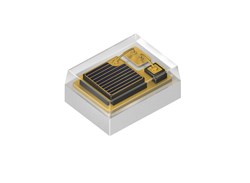The new Oslon Compact infrared light-emitting diode (IRED) from Osram Opto Semiconductors closes the gap between high-power and low-power IREDs. It offers high output in a very small package, barely larger than the chip itself, and it can be used for applications such as surveillance, digital image processing, 3D measurement, pattern recognition and gesture detection.
 |
|
The new Oslon Compact infrared light-emitting diode (IRED) from Osram Opto Semiconductors. (LEDinside/Osram Opto) |
The new infrared Oslon Compact – SFH 4710 – has been designed specifically for industrial applications. As a mid-power LED with a typical output of 270 milliwatts (mW) from an operating current of 500 milliamps (mA), it offers an output range midway between Osram's Power TopLED and Oslon Black IREDs, rounding out Osram's IRED product range.
The new SFH 4710 IRED includes a small but powerful chip with an edge length of 750 micrometers (µm) – half the footprint of standard chips in the Oslon Black family. With package dimensions of 1.6 mm x 1.2 mm x 0.8 mm, the Oslon Compact is not much larger than the chip itself and is one of the smallest in its output class. "Our new Oslon Compact has excellent heat dissipation properties and can operate at high currents," said Sevugan Nagappan, IR Product Marketing Manager at Osram Opto Semiconductors. "The high output is made possible with state-of-the-art thin-film chip technology and, combined with the small package, opens up numerous new applications, particularly where there is very little available space but performance demands are high. And, if required, components can be packed very close together to increase the optical output with a high degree of flexibility."
This infrared light emitting diode has an emission angle of +/- 65° and does not need internal optics or reflectors. Without external optics, the IRED perfectly covers the near-field range of a few meters and is very suitable for applications such as eye tracking and gesture detection.
Its light can also be successfully injected into narrow-angle external optics. With external optics, it is ideal for illumination in surveillance applications and for machine vision tasks such as pattern recognition and 3D measurement because the wavelength of 850 nanometers (nm) is barely perceptible to the human eye but can be very easily detected by camera systems.





 CN
TW
EN
CN
TW
EN






